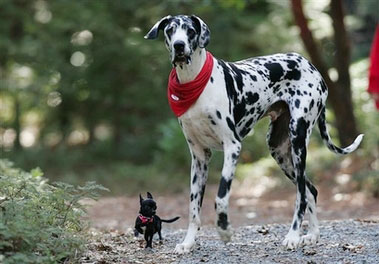Scientists: Genes determine dogs' sizes
(AP)Updated: 2007-04-06 14:16
 This undated handout photo provided by the journal Science shows Gibson, a Great Dane, right, and Zoie, a Chihuahua in Grass Valley, California. [AP]  |
Dogs have the largest variation in body size of any land animal, so researchers led by Elaine A. Ostrander of the National Human Genome Research Institute decided to look into the reasons why.
They found a section of genes that controls small size in dogs and reported their results in Friday's issue of the journal Science.
Learning how growth is controlled can improve the understanding of cancer and other diseases caused by growth gone awry, Ostrander said in a telephone interview.
And the research adds to the basic study of variations, perhaps improving knowledge of the differences between people, she added.
K. Gordon Lark of the University of Utah, a co-author of the report, pointed out that dogs have 200 to 300 diseases in common with people, including high blood pressure, autoimmune diseases and cancer.
"They also share our environment, so if there is an environmental influence that can trigger disease," dogs will be going through the same process, he said in a telephone interview.
"So, if we can solve this in dogs, that's a fantastic jump ahead," Lark said.
Keith E. Murphy, principal investigator at the Canine Genetics Laboratory of Texas A&M University, said, "What you've got here is the first piece of that puzzle."
"That's very important and you're looking at almost a sort of cascade effect, if you will, and we would hope that these findings, maybe you can extend to diseases ... maybe even cancer," said Murphy, who was not part of the research team.
Lark's Portuguese water dog, Georgie, had died and he was seeking a new one. Hearing he was a geneticist, the breeder urged him to work on dog genes.
So he began the Georgie project, studying the genes of the Portuguese water dog, a breed that comes in a wide range of sizes from 25 pounds to 75 pounds.
Ostrander and colleagues then extended that to a range of large and small breeds and the researchers located a section of DNA that varied between large and small breeds in most cases.
Known as a regulatory sequence, the difference is on dog chromosome 15 next to a previously known gene named IGF1, for insulin-like growth factor 1. The hormone controlled by the IGF1 gene helps mammals ¡ª including people ¡ª grow from birth to adolescence.
In small dog breeds a mutation in the sequence next to the gene kept them from growing larger, the researchers said.
"We know this is only part of the story, but it's a necessary part of the story," said Ostrander, who noted there some exceptions, with the small-dog sequence appearing in larger dogs.
Other yet-unidentified genetic factors cause the exceptions, said Kevin Chase of the University of Utah, another co-author.
Overall, 21 researchers studied 3,241 dogs from 143 breeds, ranging from bichon frise, Chihuahua, Maltese, Pomeranian, toy poodle, pug and Pekingese to Saint Bernard, Newfoundland, mastiff, Great Dane, Irish wolfhound and standard poodle.
Dogs are descended from wolves, having been domesticated 12,000 to 15,000 years ago. Selective breeding has produced the many different types of dogs that exist today.
Judging from ancient artwork, small breeds were developed quite early, Lark said.
A study of several hundred modern wolves didn't find any with the small-dog marker, he said, but it is possible there were small wolves in ancient times.
"If you're a primitive man you would adopt the small wolf, not the big one," he said. And for a small wolf, life would have been easier hanging around people looking for scraps than competing with larger wolves in the wild.
And, he added, unlike today when dogs are mainly companions, in the past there was plenty of work for small dogs to do ¡ª they hunted rats and other vermin, did some herding and could be excellent watchdogs.
Jeff Sossaman of the American Kennel Club Canine Health Foundation said researchers there are "really excited" about the findings.
"The canine model is a perfect model for humans because we share 85 percent of our genetic makeup. So, when we find the gene on the canine side, you can directly collate that with the human," said Sossaman, who was not part of the research group.
The research was funded by the National Human Genome Research Institute, National Science Foundation, National Institute of General Medical Sciences, Judith Chiara Charitable Trust, Mars Inc. and the Nestle Purina Co.
|
||
|
||
|
|